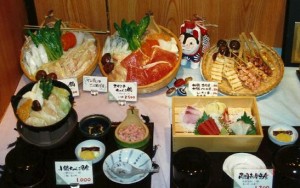One of the joys of traveling in a foreign country is eating in local places where you know for a fact that the food will be authentic and delicious. Your EF tour takes the guesswork out of two of your meals, breakfast and dinner, by including them in your program fee. No matter what country you are in, that leaves you with the opportunity to explore some interesting places for lunch. If you are planning a tour of Japan with your group, you and your students should not feel intimidated by any language barrier when you are on your lunch breaks. You can find affordable places for lunch in Japan and it’s all good.
1) Use “sampuru” for guidance: Encourage your students to check out the restaurants in large department stores for lunch. These restaurants will serve a variety of foods and it is very easy to make your choices even if you do not speak any Japanese. Before you go into the restaurant, you will see large display windows filled with the menu selections. As you look closely, you will discover that even though the food looks good enough to eat, you can’t eat it. All of the dishes on display are made from plastic. Many restaurants have these colorful displays of what they serve to customers. The plastic foods are called sampuru (from the English word “sample”). On more than one occasion, I have motioned the waitress to come out to look at the display case with me so that I could show her what I wanted to order. You and your students should not be shy about doing this. The prices will also be displayed with the plastic food.
2) Pictures can help you make a decision: Some eating places may have menus with photographs of the selections. If you get into a small establishment that does not have menus, you can look at what the other customers are eating and just point to the food when your order is being taken. Try to say Are o kudasai (“May I have that?” or “Please give me that.”) Some local restaurants are small enough that when you are sitting at the counter, you can peer over it to see what is being prepared by the cook. If you have a book or list of useful Japanese phrases with you, try to make some conversation with the staff in these small places. Lots of restaurants have photo displays of their menu selections with the prices. Just make sure your students are aware of the Japanese exchange rate for the yen.
3) Grab a meal from a 7-Eleven: Your students can buy a picnic lunch at the 7-Eleven convenience stores that are found all over Japan. They can buy the usual snack foods they enjoy back home, but also good, healthy choices for lunch like sandwiches and seaweed-wrapped rice balls (called onigiri). My Japanese mother used to make onigiri for our school lunches instead of Western sandwiches until my siblings and I protested that we wanted American food. The 7-Eleven chicken-and-vegetable sandwiches are the best. Students should try the bento boxes (takeaway boxed lunches) that are filled with many familiar-looking foods such as potato salad, rice, and chicken.
4) Eat “taichigui” style: It’s fun to eat at inexpensive places such as the taichigui (”standing up”) restaurants where you can purchase a bowl of noodles like udon or ramen and eat while you are standing up. Don’t forget that it is customary to noisily slurp your noodles while you are eating. Just don’t blow your nose at the table with the napkin or hot towel provided for you. This is a big “no-no” in Japan. Eating a big bowl of noodles for lunch in most restaurants will not hurt your budget. Once your students have tasted real ramen, they will find it hard to go back to eating the packaged kind at home. If your students don’t find noodles to be filling enough for lunch, they should try to order some gyoza or shumai as a side dish. Originally from China, gyoza are fried and shumai are steamed bite-sized pastries filled with meat and vegetables.
5) Buy unique items from vending machines: Vending machines can be another affordable way for your students to eat lunch. I watched a short video on The Wall Street Journal’s website called “In Japan, Tomorrow’ Vending Machines Today.” They are everywhere in Japan and offer a tremendous variety items for sale, including underwear. The beverage vending machines are the most numerous and some make drink suggestions based on the age and gender of the customer. You can find many that dispense food such as sandwiches, instant noodles, hot dogs, sushi, and fresh fruit like bananas. My students loved seeing the vending machines that sell a popular milky soft drink called Calpis and some were adventurous enough to drink it. Eating your lunch from a vending machine can also save you time so that you can do some exploring on your own during your break.
I am not offering this as one of my tips because I’m a firm believer that my students should try as many of the local foods as possible, but if you and your students grow weary of eating Japanese food, you can certainly have your choice of the many American fast-food restaurants in Japan. McDonald’s (called Makudonaldo in Japanese) will offer some menu selections that will be different from the ones in the United States and the same can be said for Kentucky Fried Chicken (which the Japanese call “Kentucky”). Just be aware that while the customer service may be exemplary in Japan, the prices are significantly higher. I try to practice what I preach, but I have eaten a meal or two at American fast-food chains in Japan.
Readers, what are your own tips for eating lunch in the many countries you have toured with your students?
Related articles



